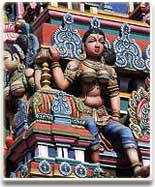Heritage
While most written records and entire edifices that testify to India's contribution to civilisation have been obliterated over time, some of them from the close of the last millennium are an eloquent reminder of the vitality of a continuing civilisation for at least 5000 years. The meeting of different cultural traditions can be seen in the innumerable forts, palaces, monuments and tombs that dot the Indian landscape.

The incomparable, intoxicating and inimitable country of India is known the world over for its rich heritage. The land of the saintly sages and the royal rulers boasts of colourful customs and timeless traditions. The people here carry on with the legacy of their own lands and beautiful buildings act as evidence of the elegant architecture they have inherited. Indian heritage is like a rainbow of multiple facets like performing arts, crafts, religion, customs, traditions, beliefs, philosophy, history, health, medicine, travel, cuisine, monuments, literature, painting and languages.
In order to explore the cultural heritage of India one needs to enjoy the components of culture like music, dance, sculpture and other fine arts, festivities, languages spoken, traditional beliefs, customs and food. In Indian heritage music is a cryptic experience that is integral to human existence. India boasts of dance forms that range from temple dances like Bharatnatyam, Odissi and Mohiniattam, to Kathakali, symbolising the victory of truth over falsehood. Kathak and Kuchipudi are the means to recite religious and mythological tales to the accompaniment of music, mime and dance. Manipuri and Dandiya Raas represent the celebration of Radha-Krishna's togetherness.
 The talent and hard work of the Indian craftsmen and the sculptors is revealed in the age-old
monuments and statues. The Indian calendar is a yearlong procession of festivals. These are both varied in origin and large in number.There are innumerable national, regional, local, religious, seasonal and social festivities. This is due to the fact that India is a land of gods, goddesses, saints and people who believe in building and maintaining relationships.
The talent and hard work of the Indian craftsmen and the sculptors is revealed in the age-old
monuments and statues. The Indian calendar is a yearlong procession of festivals. These are both varied in origin and large in number.There are innumerable national, regional, local, religious, seasonal and social festivities. This is due to the fact that India is a land of gods, goddesses, saints and people who believe in building and maintaining relationships.
The linguistic heritage of India reveals six groups, namely, Indo-Aryan, Dravidian, Sino-Tibetan-Mongoloid, Negroid, Austric and others into which the Indian languages may be categorised. Indian heritage also charms the tourists with customs and ceremonies. The captivating and traditional customs appeal because of the grace and beauty they bestow on the routine business of living till death. The major culinary influences on Indian cuisine resulted from significant historical invasions. Now the culinary heritage makes India the perfect destination for a gastronomic treat.
 Another aspect of the Indian heritage are the traditional health and medicines of India that have their roots in Ayurveda, the Charak Sahita, and the experiments performed by ancient Indian gurus. These health systems not only aimed at curing people from different diseases, they were also aimed at cleaning the body and mind. In fact, these systems lay more emphasis on prevention than on cure. Traditional health sciences of different parts of India mainly originate from Ayurvedic system of medicines. Another important way of keeping the body and soul fit was through Yoga, practised since ancient times.
Another aspect of the Indian heritage are the traditional health and medicines of India that have their roots in Ayurveda, the Charak Sahita, and the experiments performed by ancient Indian gurus. These health systems not only aimed at curing people from different diseases, they were also aimed at cleaning the body and mind. In fact, these systems lay more emphasis on prevention than on cure. Traditional health sciences of different parts of India mainly originate from Ayurvedic system of medicines. Another important way of keeping the body and soul fit was through Yoga, practised since ancient times.
The Indian architectural heritage shows a yearning for continuity and tradition, but if you look closely at the 4,000 years' history of Indian architecture, changes and dynamism are spelt loudly and clearly. Starting from the urban architecture of the Harappan civilization to the contemporary architecture of India, change has always been vital. Indian architecture of the old has taken influences liberally from the regular inflow of cultures coming to India. In turn, India also played a major role in influencing and shaping the architecture of South East Asian countries. Travel to India and experience the architectural heritage scattered through the length and breath of the country. The architectural wonders of India include more than twenty World Heritage Sites and several hundreds of less-renowned sites
 1>
1>